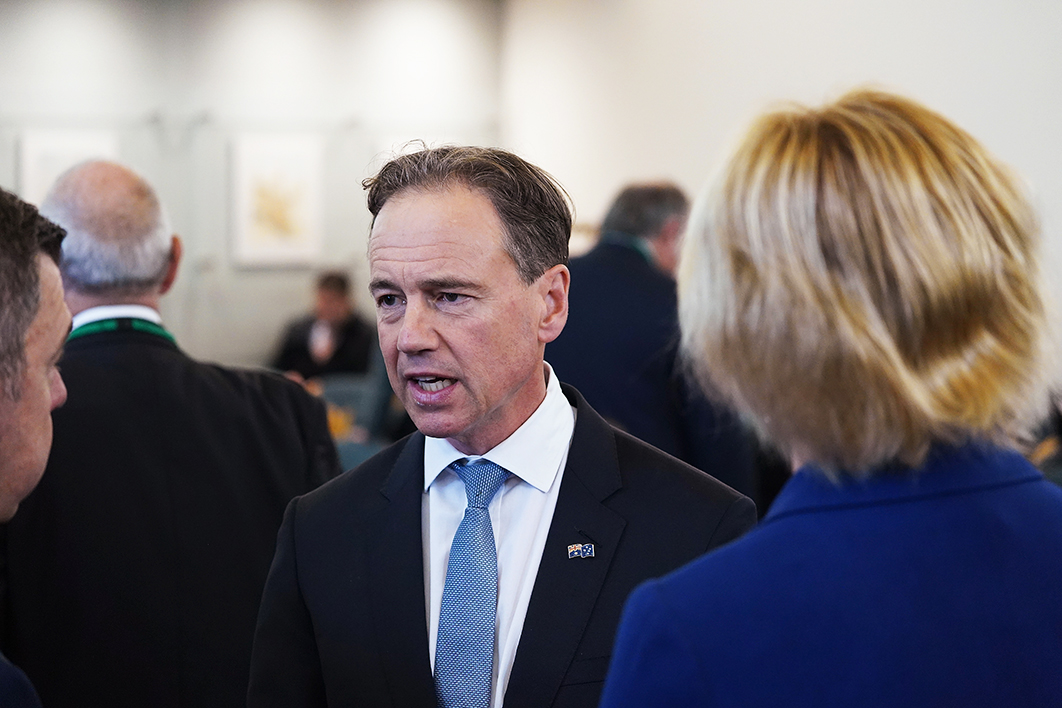If private health insurance really is “in the Coalition’s DNA,” as Tony Abbott once claimed, it might be time for the government to seek some gene therapy. Despite health minister Greg Hunt’s efforts to improve the system by simplifying the options on offer and discounting premiums for young people, the “death spiral” predicted by the Grattan Institute shows no sign of abating.
The latest figures from the Australian Prudential Regulation Authority reveal that 28,000 Australians dropped their hospital insurance in the June quarter, the largest group being twenty- to twenty-four-year-olds. Membership numbers are at their lowest level in fourteen years.
Private health insurance — and particularly the $6 billion rebate and other tax concessions given to policy-holders — has long been criticised by left-leaning commentators for its inefficiency and inequity. But conservative commentators and groups are increasingly adding their voices.
“Neither side of politics in Australia has presented a coherent view of the role of private health insurance,” says Andrew Podger, a former secretary of the health department and the prime minister’s department. “They have left us with a hotchpotch of subsidies and regulations that are confusing, distorting, costly and inequitable.”
Australian Dental Association president Carmelo Bonanno has even advised consumers against taking out private insurance. “While dental rebates represent more than 50 per cent of those paid under General Treatment cover,” he says, “their low levels mean policy-holders would be better off saving their money and paying for dental care only when they need it.”
More colourfully, a former Liberal adviser has admitted that private health insurance is “about as popular as a fart in a lift.”
The problem dates back thirty-five years to when Medicare was introduced without a clear vision of how private insurance would function alongside a universal government-run health insurer. Since then, the private health insurance system has struggled to find a viable role, and has had to be propped up by an increasingly complex (and expensive) system of subsidies and penalties.
None of those measures has succeeded in persuading the majority of Australians that private health insurance is good value. Even in the wealthiest one-fifth of households, only around 80 per cent of households are fund members, despite the fact that in many cases the premiums would cost less than the tax concessions received in return.
Private health insurance is now so complex and confusing that even the health funds themselves have difficulty understanding the details of their products.
Fundamental to this problem is a lack of agreement about the role the private funds should be playing in our health system. Consumers think these insurers are there to protect them from unexpected healthcare costs, and feel let down when they are confronted with high and open-ended expenses.
Doctors (or at least their main representative groups) value private insurance because it funnels people into the private health sector, where earnings are higher than in the public sector. They resist any attempts by the funds to moderate or control gap payments.
Private hospitals want the private health funds to provide a captive market for low-risk, high-volume procedures, such as joint replacements, which provide their highest profits, and then resent the fact that some consumers choose to use their insurance to get access to these services in public hospitals.
Governments see private insurance as a way of extracting more money for healthcare from the community without tax increases, even though the community winds up paying more overall, and even despite evidence that many consumers would prefer private insurance subsidies to be spent on improving public health services.
Private health insurance obviously can’t fill all these roles simultaneously. To earn its place in the Australian health system it has to meet the needs of consumers and the broader community more efficiently and effectively than the alternatives. It shouldn’t be supported because it provides an income stream for providers or props up a system of health financing that no longer serves the interests of the community.
In this light, let’s look at three potential roles for private health insurance and assess their viability.
1. Managing high, unexpected healthcare costs
One potential role for private insurance is to help consumers deal with out-of-pocket healthcare costs, which make up around 17 per cent of Australia’s total health spending, or $29 billion a year. Not all of these costs create problems for consumers, but there is good evidence that difficulties in affording out-of-pocket costs are widespread, and prevent or delay access to essential health services.
Out-of-pocket costs are diverse and can be categorised in many different ways. One way is to categorise them as low-risk, high-cost (such as those associated with major illnesses and injuries); another is to categorise them as high-risk, low-cost (such as those incurred in receiving more predictable and routine healthcare).
From a consumer perspective, those two types are obviously very different. The out-of-pocket costs associated with a low-risk, high-cost event are generally unpredictable and often financially challenging for all but the wealthiest in the community. The highest claim paid by a private fund in 2018 was $531,777, an amount that most Australians would clearly not be able to afford. It isn’t surprising that consumers want to insure against potentially devastating expense.
Judging by complaints to the Commonwealth Ombudsman, this is a key reason why many consumers take out private health insurance. In this sense, it is similar to other forms of household insurance, such as house and car insurance, which share the costs associated with low-risk, potentially catastrophic events among a group of people.
In practice, though, private health insurance doesn’t function like other forms of insurance, which limit consumers’ exposure to high expenses by capping the costs they can incur. In fact, private health insurance generally works in the opposite way, by capping the amount that the health fund pays, leaving consumers exposed to open-ended payments. And the gap payments, exclusions and annual limits included in most private insurance policies can mean that even consumers with the highest level of cover can find themselves facing crippling healthcare expenses with only patchy support from their health fund, particularly for out-of-hospital services.
For private health funds to work as genuine insurers providing cover for high and unexpected healthcare expenses, a cap would be needed on policy-holders’ exposure to open-ended costs. Funds would have to strike fee agreements with medical professionals, something that government can’t mandate. Insurers would also need to cover a greater range of services, and relax current annual limits on claims.
This highlights the problem of designing insurance in isolation from the broader private health sector. If private insurers increased coverage and removed annual limits in the current policy environment premiums would be likely to rise even higher and the downward spiral would continue. Redefining private health insurance, as a genuine insurer of low-risk, high-cost healthcare, can only happen if the government is willing to also tackle the broader policy challenge of out-of-pocket expenses. There’s no easy solution: it will need a comprehensive and multifaceted strategy that goes well beyond the narrow and provider-centric approach taken so far by the government.
2. Managing ongoing, predictable out-of-pocket costs
Private health insurance could support consumers in managing the cost of more frequent and predictable, but lower-cost, forms of healthcare, such as routine dentistry and allied health services like physiotherapy.
For most healthy people, most of the time, these services don’t create overall affordability problems, although some consumers may experience short-term cashflow problems when using them. But for a minority of consumers with very low incomes and/or other unexpected expenses, even these costs can be prohibitive. Research by the Consumers Health Forum of Australia has found that the accumulation of relatively small costs over a long period can be burdensome for some people, especially when added to the other costs associated with illness and injury, such as transport expenses and loss of income.
The Forum’s study is backed up by other research showing that many people delay or don’t use essential healthcare because of cost. The Australian Bureau of Statistics found last year that 13 per cent of people aged fifteen to thirty-four years delayed seeing, or didn’t see, a medical specialist on cost grounds, and 9 per cent of people aged sixty-five years and over didn’t see a dentist when required, for the same reason.
When people delay using essential healthcare, their problems are likely to become more serious, and they can cost the community more over the longer term. Cost barriers are probably one reason why Australia has more than 715,000 potentially preventable hospital admissions every year, according to 2016–17 figures.
Private health insurance does play a role in funding occasional, low-cost healthcare, in particular via extras cover for dental and allied health services. But this isn’t really insurance in the strict sense because it doesn’t cap consumers’ exposure and subsidises services that policy-holders are most likely to use. In practice, extras cover functions more like a prepayment plan for certain forms of healthcare, with the fund collecting regular payments from consumers and in return providing them with a fixed amount towards the cost of an episode of care. And the amounts are usually fairly modest: a typical policy will rebate $28 for a standard physiotherapy consultation, for example.
This may make healthcare costs more predictable, but for consumers wanting to spread their healthcare costs over time, private health insurance is an unnecessarily complicated and cumbersome vehicle. A credit card or another form of payment system, such as Afterpay, would be simpler, cheaper and more user-friendly, and could also be used to cover all forms of healthcare, not just those covered by the private funds.
Private insurance is also unlikely to meet the needs of cash-strapped consumers who struggle to cover even occasional healthcare costs. Even if they can afford the premiums, many consumers report not being able to afford the gap payments that come with using their insurance to access services.
For these reasons it is no surprise that some experts and consumer groups advise against taking out extras cover. The former chief executive of the Private Health Insurance Administration Council, Shaun Gath, once stated that most people would be better off forgoing this form of cover and simply paying for dental, optical and other treatments out of their own pockets. Australia’s leading consumer group, Choice, has also advised consumers to think about dropping their extras cover altogether.
So, given that private health insurance isn’t meeting the needs of those consumers who can’t afford basic healthcare or those who want their healthcare costs to be more predictable and regular, it makes no policy sense for private insurers to continue as funders of low-cost services for people with typical healthcare needs.
A more equitable and efficient use of the public funds currently going into private health insurance would be to help low-income people get access to basic services, and/or to address some of the gaps in the public health system, for example by establishing a universal dental care system.
3. Cross-subsidising healthcare
Over their lifetimes, most people are likely to require significant amounts of healthcare. At any given time, though, the use of healthcare services varies significantly across the population. Older and sicker people generally use much more than those who are younger and healthier. As poor health can reduce earning capacity, people are often least able to pay for health services when they most need them. Spreading the costs of healthcare more evenly across the population, using cross-subsidies from low users to high users, supports equitable access to care and makes sense on both ethical and practical grounds.
Medicare manages cross-subsidisation very efficiently and with a 100 per cent participation rate because it is universal and compulsory. The government-imposed “community rating” requirement — which prohibits private health funds from adjusting premiums according to risk — achieves a degree of cross-subsidy; without it, many people wouldn’t be able to afford private insurance, including those with the highest levels of need.
But community rating also means higher premiums for younger and healthier people than would be the case in a purely risk-rated system. Many low-risk people consequently decide that private insurance doesn’t offer them good value, and so drop their cover. The risk pool of the insured population increases, driving premiums up and causing more low-risk people to drop their cover.
Governments in Australia have tried to counter this effect by subsidising the cost of private health insurance for younger people and penalising the more affluent who don’t have it. The tax rebate to encourage younger and healthier people to take up private insurance currently costs the government around $6 billion, yet young and low-risk consumers are increasingly opting out of the system.
While cross-subsidisation is a valid goal, it is clearly inefficient to pay billions of dollars every year in an attempt to make private health insurance redistributive when Medicare can do that at no additional cost to the community. Governments should focus on achieving cross-subsidisation via Medicare and the tax system rather than relying on the expensive and inefficient mechanism of private insurance.
Private health insurance’s “death spiral” reflects the failure of successive governments to articulate a sustainable role for private funds within the context of Medicare. To resolve this issue, the government needs to decide which (if any) of the possible functions of private health insurance should be preserved and which no longer have a viable role.
We know that many consumers want to be protected against the risk of a catastrophic illness or injury, while others might want help in spreading their healthcare costs more evenly over time, and others need direct support to cover even basic care. We also know that spreading health costs across the population is efficient and equitable.
In its current form, private health insurance doesn’t meet any of those needs well. It is unable to protect consumers from the risk of open-ended expenses; it is an unnecessarily expensive and complex way to help consumers manage their health costs; it doesn’t remove the cost barriers for the most disadvantaged households; and it requires billions of dollars in government subsidies to redistribute costs, which Medicare does automatically.
It is difficult to see how the government can justify an ongoing role for private insurance in its current form, let alone continue to subsidise it to the tune of billions of taxpayer dollars every year. But a narrower role for private health insurance may be welcomed by some consumers who want to protect themselves from high and unexpected healthcare costs. This is a major gap in Australia’s health system and one that has been largely ignored by both sides of politics. Of course, not everyone can afford private health insurance, but the revenue from current rebate subsidies and tax concessions could be used to fund a comprehensive health safety net for all consumers.
If the government is interested in exploring this option it should consider conducting a review of the private health sector, including private health insurance and out-of-pocket costs, along the lines of the review proposed by Labor. This would give Greg Hunt and his colleagues the opportunity to explore alternatives for private health insurance in the context of broader health system reforms and to consult with consumers about their views and preferences. As the debate so far has shown, solutions proposed by those with vested interests are unlikely to reflect consumers’ priorities.
A review would also give the Coalition the opportunity to reassess whether private insurance should be a fundamental part of its political identity. Being wedded to a funding system that has outlived its usefulness is not in the interests of either the current or future Coalition governments. All health funding mechanisms, including private health insurance and Medicare, exist to serve the needs of the Australian community, not vice versa. Abandoning a kneejerk attachment to private insurance could free the Coalition to develop new approaches to health funding that reflect its values while better equipping the health system for future demands. •




